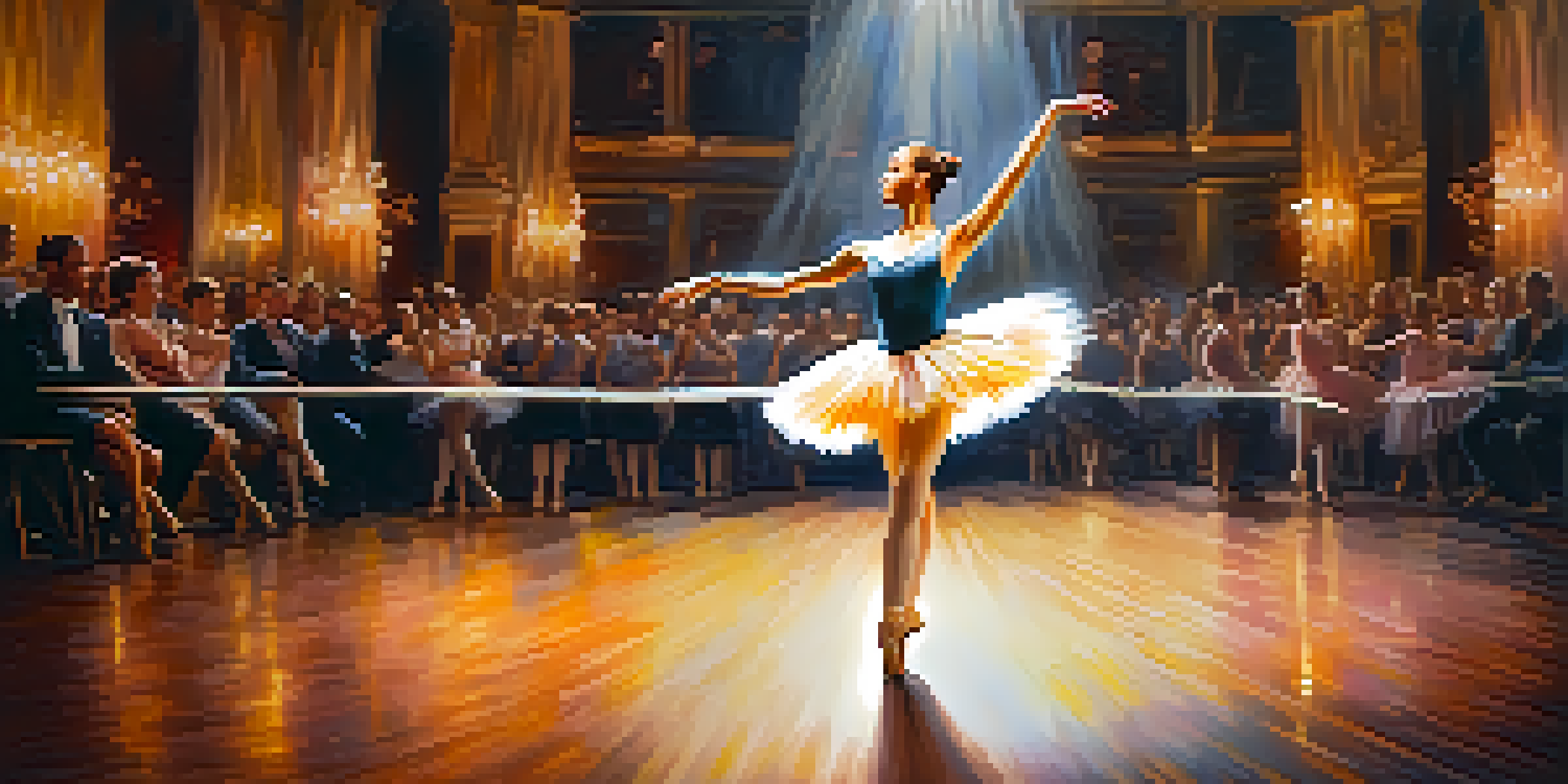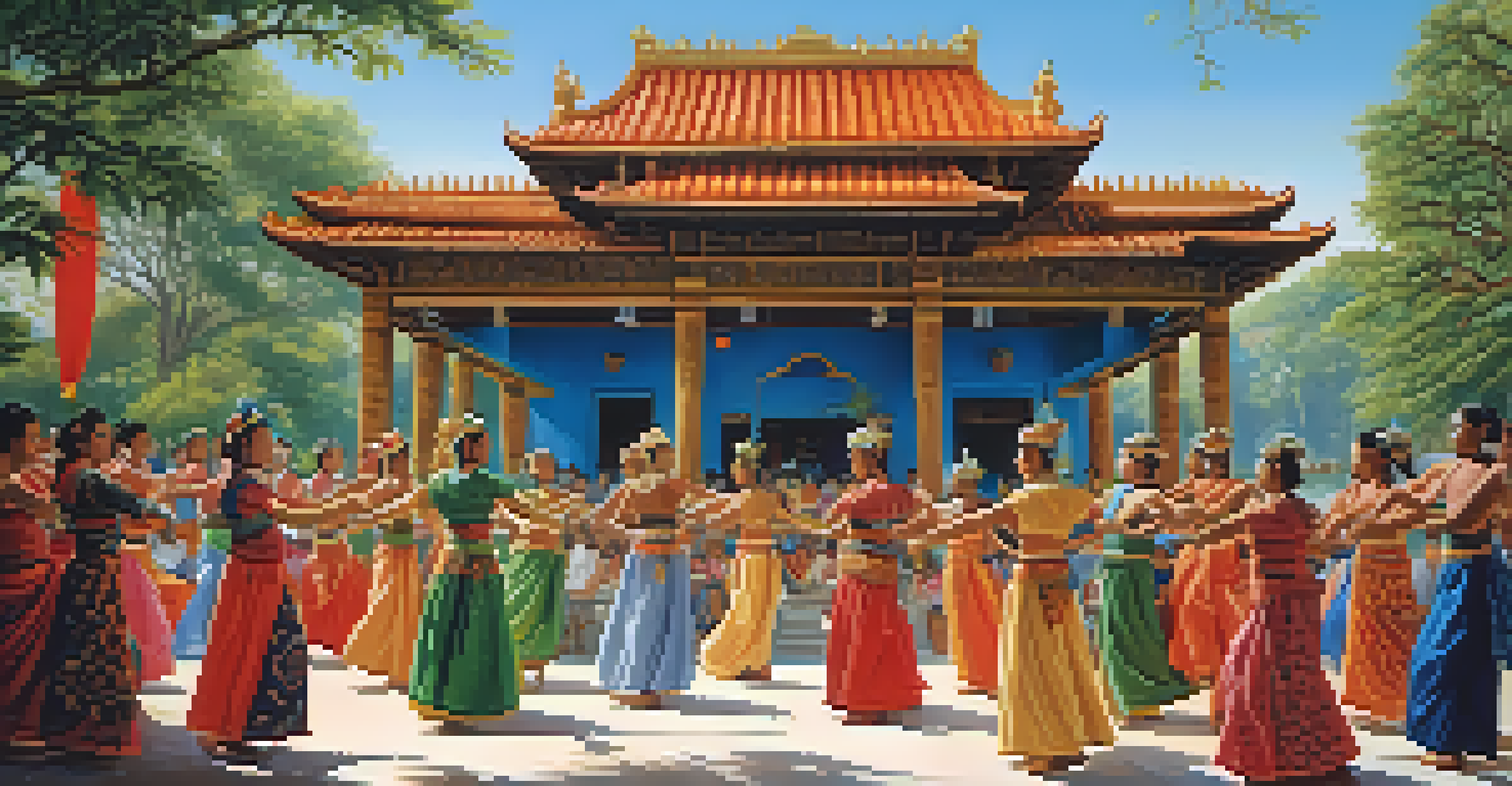Historical Influence of Dance on Visual Art Movements

The Origins: Dance as a Form of Expression
Dance has long been a powerful mode of expression, deeply rooted in human culture. From ancient rituals to modern performances, it's a language that transcends words, conveying emotions and stories. This expressive quality of dance has inspired countless artists across various visual art movements, sparking creativity and innovation.
Dance is the hidden language of the soul.
In many cultures, dance was intertwined with visual arts, as seen in ancient cave paintings depicting figures in motion. These early representations not only celebrated the act of dancing but also documented its significance in communal rituals. As artists observed the fluidity and grace of dancers, they began to incorporate similar themes into their work, fostering a rich dialogue between movement and visual representation.
This interconnection set the stage for future art movements, where the dynamism of dance would continue to influence how artists captured human emotion and experience. The vibrant interplay between these two forms of art created a legacy that artists still draw upon today.
The Renaissance: Dance in Art and Culture
During the Renaissance, the revival of classical ideals brought a renewed interest in the human form and expression. Artists like Botticelli and Raphael often featured dancing figures in their works, emphasizing beauty, grace, and harmony. This period marked a pivotal moment where the elegance of dance was celebrated and immortalized through painting, capturing the essence of movement.

The influence of dance was not limited to visual aesthetics; it also reflected broader cultural shifts in society. As people began to embrace the idea of individual expression, dance became a symbol of freedom and creativity. Artists began to portray dancers not merely as subjects but as embodying the spirit of their time, illustrating the connection between art and the dance culture.
Dance: A Universal Expression
Throughout history, dance has served as a powerful form of expression that transcends language and connects cultures.
This fusion of dance and visual art during the Renaissance set the groundwork for future explorations in both fields, inspiring artists to delve deeper into the complexities of movement and emotion in their work.
Impressionism: Capturing Movement and Emotion
The Impressionist movement in the late 19th century brought about a significant shift in how artists approached the depiction of movement. Artists like Edgar Degas famously captured dancers in various poses, using loose brushwork and vivid colors to convey the ephemeral quality of dance. His works illustrate not just the dance itself but the energy and emotion behind it, bringing the viewer into the moment.
The dance is a poem of which each movement is a word.
Degas saw dance as a subject that could embody the fleeting nature of life, a theme that resonated deeply with the Impressionists. Their focus on capturing light and movement paralleled the qualities found in dance, leading to a unique synergy between the two art forms. This collaboration opened new avenues for experimentation in visual art, allowing artists to express a sense of immediacy and intimacy.
Through the lens of Impressionism, dance became a vibrant element of art that emphasized the beauty of the present moment, pushing the boundaries of how movement could be represented on canvas.
Expressionism: Emotion through Movement
As art movements evolved, Expressionism emerged in the early 20th century, focusing on the emotional experience rather than realistic representation. Artists like Egon Schiele and Wassily Kandinsky drew inspiration from dance to express inner feelings and existential themes. The dynamic lines and exaggerated forms in their works reflect the passion and intensity found in dance.
Expressionist artists often used dance as a metaphor for the struggles of the human condition. They understood that movement could convey a range of emotions, from joy to despair, creating a powerful visual language. This connection allowed artists to explore deeper psychological themes, highlighting the emotional resonance of both dance and visual art.
Art Movements Reflect Dance's Influence
Various art movements, from the Renaissance to Modernism, have drawn inspiration from dance, showcasing its impact on visual representation.
By prioritizing emotional truth over technical perfection, Expressionism showcased the transformative power of dance, demonstrating how movement could serve as a catalyst for profound artistic expression.
Modernism: Breaking Boundaries of Form
Modernism marked a radical departure from traditional art forms, encouraging artists to experiment with abstraction and new techniques. In this era, dance continued to play a vital role in shaping visual art, as seen in the works of artists like Sonia Delaunay and Martha Graham. Their collaboration blurred the lines between dance and visual art, creating immersive experiences that challenged conventional perceptions.
This period also saw the rise of performance art, where the act of dancing became an integral part of the artistic experience. Artists began to explore the concept of movement as a medium, allowing them to express ideas in a more fluid and dynamic way. The use of dance in visual art became a powerful tool for communication, inviting viewers to engage with the work on multiple levels.
Through these innovative approaches, Modernism redefined the relationship between dance and visual art, highlighting movement's role in expanding artistic boundaries and fostering new forms of expression.
Contemporary Art: Dance's Ongoing Influence
In the contemporary art landscape, the influence of dance is more prevalent than ever. Artists today continue to draw inspiration from movement, integrating dance into their work through multimedia installations, performance art, and even virtual reality. This evolution reflects a growing recognition of dance as a vital art form that can enhance and transform visual art experiences.
Contemporary choreographers and visual artists often collaborate, creating pieces that engage audiences in new and unexpected ways. For example, dance in galleries allows viewers to witness live performances that interact with the visual elements of the space, creating a multi-sensory experience. This fusion of art forms encourages a deeper appreciation of both disciplines and their interconnectedness.
Contemporary Fusion of Art and Dance
Today, contemporary artists continue to blend dance with visual art, creating immersive experiences that redefine artistic boundaries.
As contemporary artists explore the boundaries of dance and visual art, they continue to celebrate the rich history of their relationship while paving the way for future innovations. The ongoing dialogue between these two art forms ensures that the influence of dance will remain a vital source of inspiration for generations to come.
Conclusion: The Dance of Art and Movement
The historical influence of dance on visual art movements reveals a fascinating interplay of creativity and expression. From ancient rituals to modern collaborations, the relationship between these two art forms has evolved, reflecting cultural shifts and artistic innovations. Dance has not only inspired artists but has also enriched the way we perceive and experience visual art.
As we look back at the various movements, it's clear that dance has served as a muse, encouraging artists to explore the complexities of human emotion and experience. The dynamic nature of dance provides a unique lens through which we can understand the evolution of visual art, highlighting the importance of movement in conveying meaning.

In celebrating this rich history, we acknowledge that the dance between art and movement is ongoing, with each new generation of artists continuing to explore and redefine their relationship. This enduring connection promises to inspire future creators, ensuring that the rhythm of dance will always resonate within the world of visual art.